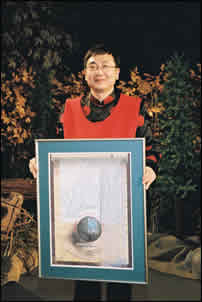|
BY TOM KEYSER
Freelance Columnist
 |
| Dr. Dejaing Long, P.Eng., accepts the 2003 CEA Award
of Excellence on behalf of the Golder team, which also
includes Dr. Mike Bender, P.Eng., Dr. Shouhong Wu, P.Eng.,
Dr. Jason Yang, P.Eng., and Les Sawatsky, P.Eng. |
He wasn't granted much leeway when he started down his career
path. The Chinese educational system, after all, made all
the important decisions for Dr. Dejiang Long, P.Eng., a Calgary
water resources engineer.
"
In those days in China, young people had limited choices
when we went to university. We were streamed into a particular
technical discipline," says Dr. Long, who studied hydraulic
engineering at Tsinghua University in Beijing before completing
his PhD at the University of Alberta.
But regrets? He wouldn't change a thing.
Dr. Long, a principal in Golder Associates Ltd., recently
travelled to Winnipeg to accept an award of excellence from
the Association of Consulting Engineers of Canada – for
a project in China, the country of his birth.
Along with his Calgary-based team, Dr. Long was recognized
for developing an innovative tool to manage the immeasurably
complicated drainage and water management system for China's
Sihu Basin. Earlier in 2003 and for the same work, project
director Long and the Golder group earned similar peer recognition
from the Consulting Engineers of Alberta.
A Personal Journey
Dr. Long doesn't mind confiding that the chance to return
to his roots and lend a helping hand to the Chinese people
was a dream come true. "That's one thing I do feel,
on a personal level. Very satisfying," he says.
But Dr. Long, a charming, soft-spoken and modest man, is
careful to spread around the credit for this significant
triumph of 21st century engineering.
World Bank hired the Golder team, which was reinforced by
flood management expert Dr. Slobodan Simonovic, P.Eng., now
of the University of Western Ontario but at the time employed
by the University of Manitoba. The bank financed a four-phase
job as a part of the Yangtze Basin Water Resources Project
by means of a loan of $550 million US. In turn, the Canadians
allied themselves with a corporate team of Japanese experts,
as well as engineers from two Chinese research institutes.
Golder became the prime subcontractor for the critical fourth
and final phase of the six-year project, helping develop
a masterly flood-management tool known as Sihu Decision Support
System software.
This DSS software package, praised by the World Bank as ground-breaking,
enables Chinese administrators to accurately forecast periods
of high water while improving existing methods of draining
flood waters from the sprawling basin.
Major Losses Averted
It's working like gangbusters, by the way. Since final software
testing work wrapped up in October 2000, the Chinese administrators
estimate that use of the software has averted more than $20
million US in flood damage.
That’s a big boost to Sihu, a primarily rural and agricultural
district north of the Yangtze. Measuring 11,500 square kilometres
in area, it is home to almost five million people.
"
During the summer flood season, the river rises as much as
five to 10 metres higher than ground elevation within the
basin," Dr. Long explains. “Extremely high dikes
keep the river at bay. But since the basin has no natural
water outlets, the Chinese rely on an extensive drainage
system."
A series of gargantuan electric pump stations acts as the
system’s main bulwark. The stations are able to discharge
2,700 cubic metres a second – about 100 times more
water than the biggest pump station in Alberta.
Meanwhile, operators try to minimize costly damage by means
of an intricate network of sluices and drainage canals, thousands
of kilometres in length. Excess water within the basin (which
annually receives 1.2 metres of rainfall) is diverted to
two lakes, which serve as holding pools.
Logistically, the management of this labyrinthine system
is a job for Superman – or Golder's DDS software.
"
The Chinese didn't have access to sophisticated management
tools. That's why we came to help them," says Dr. Long.
Local Attitudes Respected
His team's knowledge of Chinese attitudes and traditional
business methods came in particularly handy. Suspecting that
system administrators would be unlikely to accept a solution
imposed unilaterally by outsiders, Dr. Long and his team
persuaded local officials to buy in from the start.
"
We integrated the Chinese professionals into the whole process," he
says. "They had a very important say in project objectives."
In fact, most of the award-winning software package was actually
developed by the Chinese themselves, with the Canadians providing
key methodological, technological and supervisory support.
Sure, there were glitches. Dr. Long admits it was often frustrating
trying to navigate the enormously complex and sensitive Chinese
bureaucracy.
Not that it was bad enough to keep him from wanting to return.
As you read this, Dr. Long and Golder Associates are preparing
a proposal to pursue similar technological solutions on behalf
of China’s Yellow River Conservancy Commission.
|




